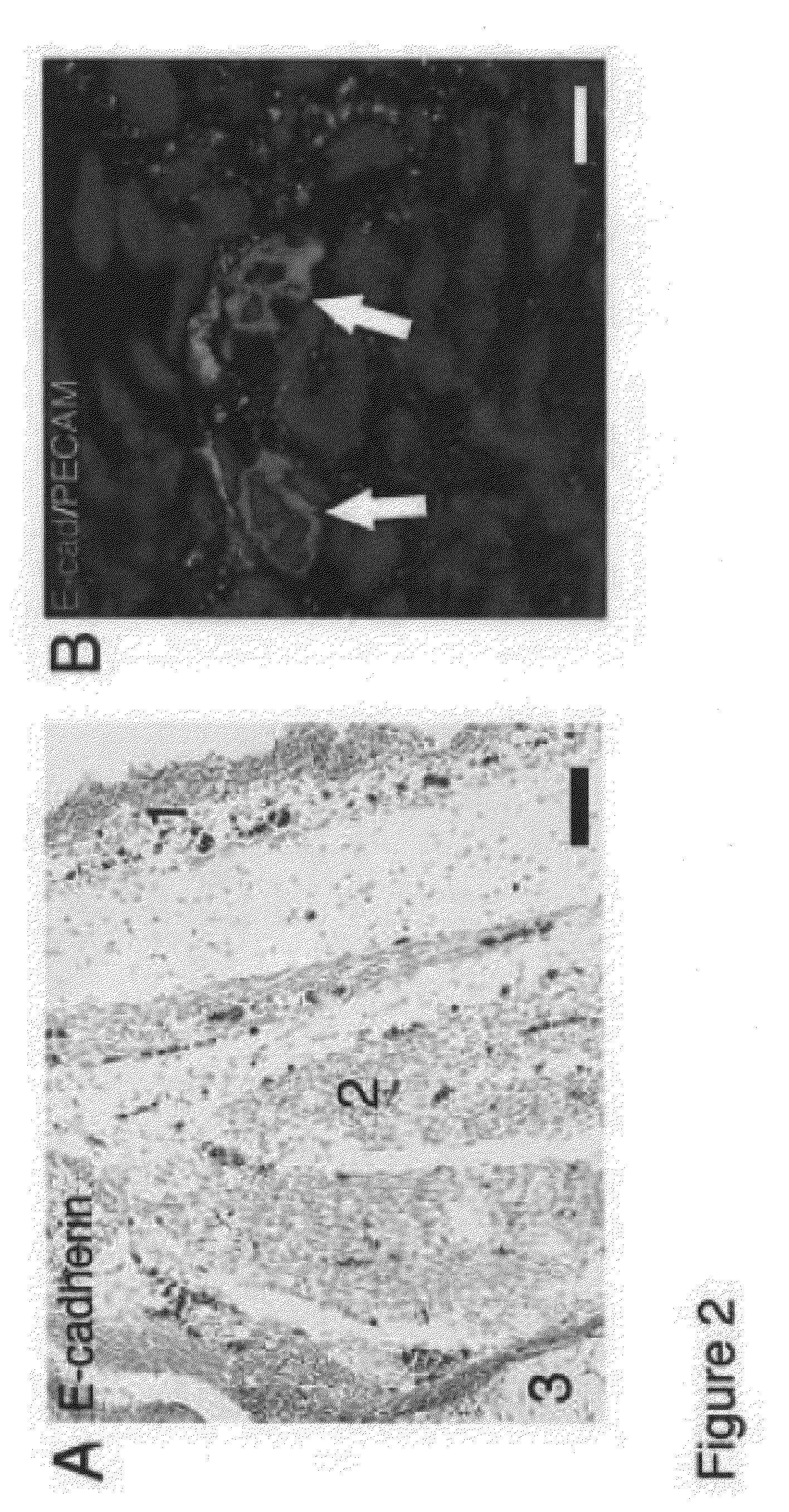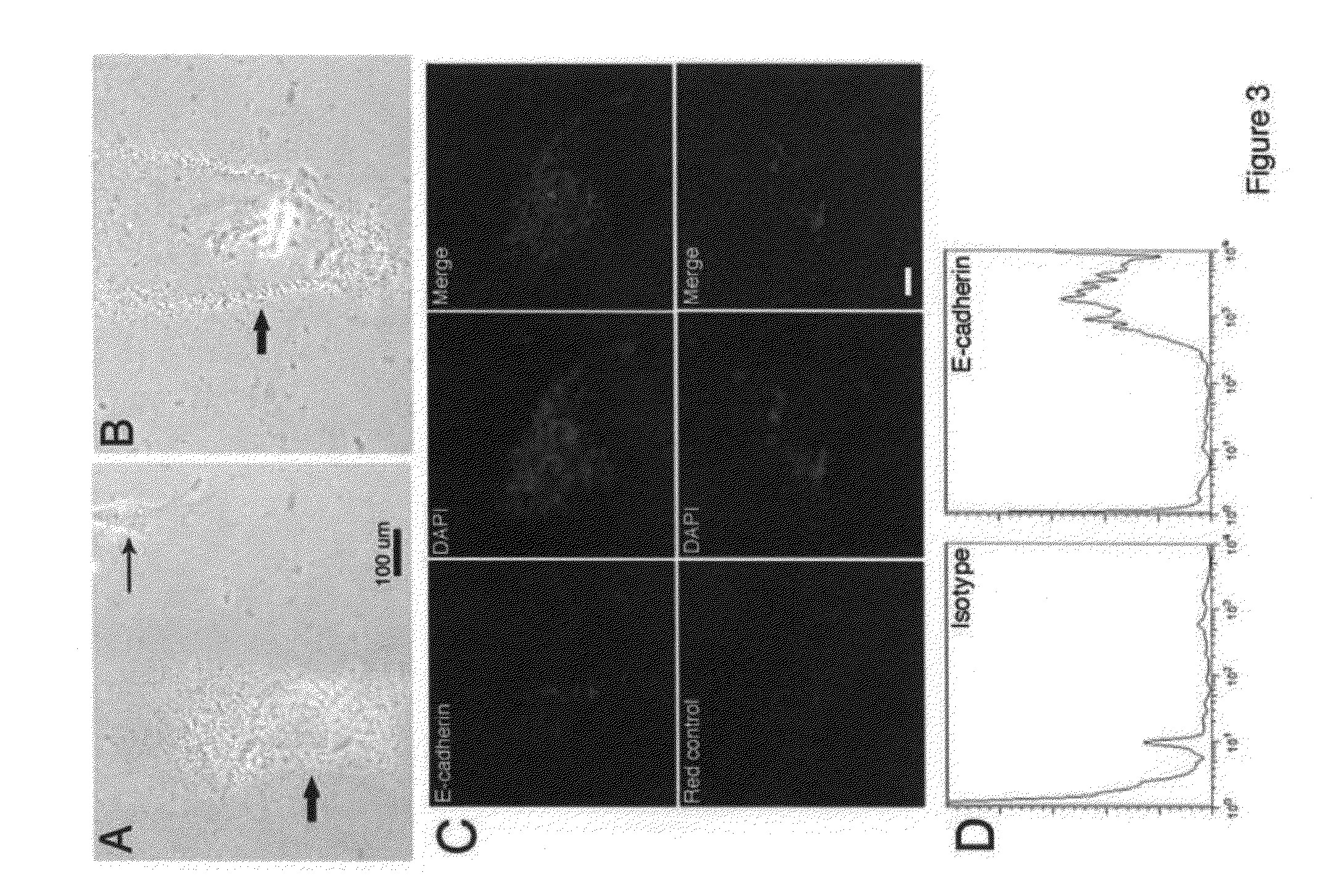Regenerative Dot cells
a dot cell and regenerative technology, applied in the field of regenerative dot cells, can solve the problems of heart tissue necrosis, scarring can happen in different tissues and organs, and patients with large scars have life-long psychological and physical burdens, and achieve the effect of high regenerative
- Summary
- Abstract
- Description
- Claims
- Application Information
AI Technical Summary
Benefits of technology
Problems solved by technology
Method used
Image
Examples
example 1
[0123]Wounds in fetal skin heal without scar, however the mechanism is unknown. We have identified a novel group of E-cadherin positive cells in the blood of fetal and adult mice and named them “Dot cells”. The percentage of Dot cells in E16.5 fetal mice blood is more than twenty times higher compared to adult blood. Dot cells also express integrin β1, CD184, CD34, CD13low and Sca1 low, but not CD45, CD44, and CD117. Dot cells have a tiny dot shape between one to seven μm diameters with fast proliferation in vitro. Most of Dot cells remain positive for E-cadherin and integrin β1 after one month in culture. Transplantation of Dot cells to adult mice heals skin wounds with less scar due to reduced smooth muscle actin and collagen expression in the repair tissue. Tracking GFP-positive Dot cells demonstrates that Dot cells migrate to wounds and differentiate into dermal cells, which also express strongly to FGF-2, and later lose their GFP expression. Our results indicate that Dot cells ...
example 2
Dot Cells: Primitive Marrow and Circulating Regenerative Fusogenic Cells
[0153]We have herein identified a novel group of circulating and bone-marrow-derived DNA and protein positive particles and termed them “Dot cells”. The morphology of blood-derived Dot cells does not match the definition of conventional eukaryotic cells. Their size ranges from 0.1 to 2 μm, and they do not have nuclear membrane or intracellular organelles. Blood-derived Dot cells have a unique self-renewal mechanism by release of grouped new Dot cells from colonies. When present with differentiated cells, Dot cells aggregate and fuse together. The fused aggregates then undergo cellular transdifferentiation. Both the nuclear and cytoplasmic components of the newly differentiated cells are derived from Dot cell fusion. In vitro expanded Dot cells form spheroids, which release fused or grouped Dot cells that contribute to tissue regeneration during in vivo wound healing. Dot cells are a newly identified cellular pop...
example 3
Dot Cell Differentiation
[0182]FIG. 16 shows FACS analysis of surface markers on either freshly sorted blood-derived Dot cells or the in vitro expanded Dot cells. Freshly sorted Dot cells express E-cadherin, integrin β1 / CD29, CXCR4 / CD184, CD90 and CD34. Only a small amount of freshly sorted Dot cells express Sca1. However, after one month in culture, the number of Dot cells that express E-cadherin, integrin β1 and CD184 is significantly reduced, and the number that expresses CD90 and CD34 remains the same. Interestingly, a significant amount of Dot cells start to express c-kit and CD45, but none express Sca1. The change of surface markers may correlate with the increased variety of Dot cell shapes in culture.
[0183]As shown in FIG. 17, Dot cells differentiate into neuron-like cells in vitro. Dot cells were cultured and they have spontaneous differentiation. FIG. 17A shows the morphology of glial cells. 17B shows that Dot cells differentiate into a neuron-like morphology.
[0184]Shown in...
PUM
| Property | Measurement | Unit |
|---|---|---|
| size | aaaaa | aaaaa |
| diameter | aaaaa | aaaaa |
| diameter | aaaaa | aaaaa |
Abstract
Description
Claims
Application Information
 Login to View More
Login to View More - R&D
- Intellectual Property
- Life Sciences
- Materials
- Tech Scout
- Unparalleled Data Quality
- Higher Quality Content
- 60% Fewer Hallucinations
Browse by: Latest US Patents, China's latest patents, Technical Efficacy Thesaurus, Application Domain, Technology Topic, Popular Technical Reports.
© 2025 PatSnap. All rights reserved.Legal|Privacy policy|Modern Slavery Act Transparency Statement|Sitemap|About US| Contact US: help@patsnap.com



